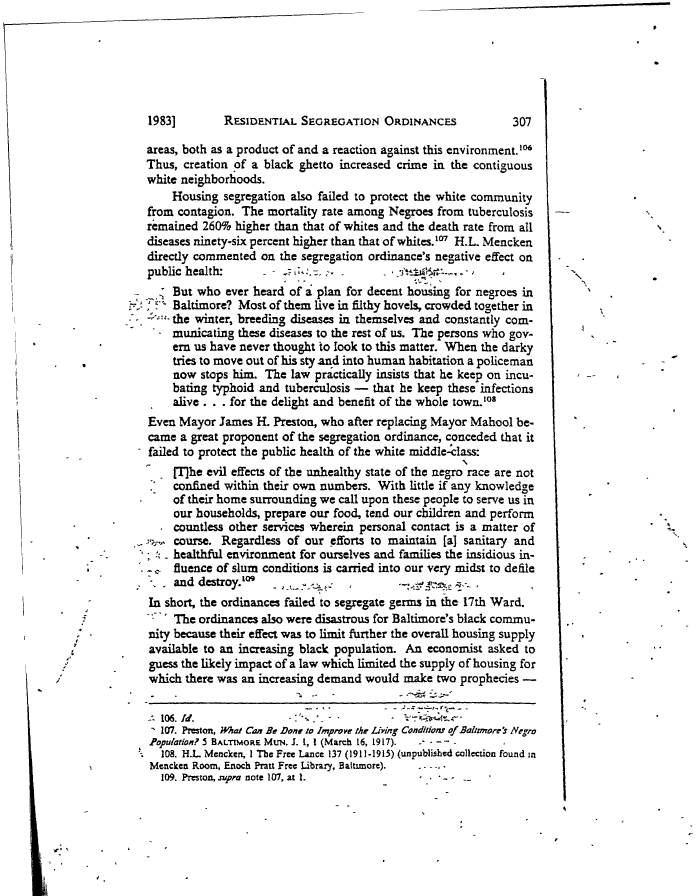 |
||||
|
Garrett Power, Apartheid Baltimore Style: The Residential Segregation Ordinances of 1910-1913, Maryland Law Review, 42 (1983) , Image No: 20 Enlarge and print image (68K) << PREVIOUS NEXT >> |
 |
||||
|
Garrett Power, Apartheid Baltimore Style: The Residential Segregation Ordinances of 1910-1913, Maryland Law Review, 42 (1983) , Image No: 20 Enlarge and print image (68K) << PREVIOUS NEXT >> |
| 1983] RESIDENTIAL SEGREGATION ORDINANCES 307 areas, both as a product of and a reaction against this environment.106 Thus, creation of a black ghetto increased crime in the contiguous white neighborhoods. Housing segregation also failed to protect the white community from contagion. The mortality rate among Negroes from tuberculosis remained 260% higher than that of whites and the death rate from all diseases ninety-six percent higher than that of whites.107 H.L. Mencken directly commented on the segregation ordinance's negative effect on public health: But who ever heard of a plan for decent housing for negroes in Baltimore? Most of them live in filthy hovels, crowded together in the winter, breeding diseases in themselves and constantly com- municating these diseases to the rest of us. The persons who gov- ern us have never thought to look to this matter. When the darky tries to move out of his sty and into human habitation a policeman now stops him. The law practically insists that he keep on incu- bating typhoid and tuberculosis — that he keep these infections alive ... for the delight and benefit of the whole town.108 Even Mayor James H. Preston, who after replacing Mayor Mahool be- came a great proponent of the segregation ordinance, conceded that it failed to protect the public health of the white middle-class: [T]he evil effects of the unhealthy state of the negro race are not confined within their own numbers. With little if any knowledge of their home surrounding we call upon these people to serve us in our households, prepare our food, tend our children and perform countless other services wherein personal contact is a matter of course. Regardless of our efforts to maintain [a] sanitary and healthful environment for ourselves and families the insidious in- fluence of slum conditions is carried into our very midst to defile and destroy.109 In short, the ordinances failed to segregate germs in the 17th Ward. The ordinances also were disastrous for Baltimore's black commu- nity because their effect was to limit further the overall housing supply available to an increasing black population. An economist asked to guess the likely impact of a law which limited the supply of housing for which there was an increasing demand would make two prophecies — 106. Id. 107. Preston, What Can Be Done to Improve the Living Conditions of Baltimore's Negro Population? 5 BALTIMORE MUM. J. 1, 1 (March 16, 1917). 108. H.L. Mencken, 1 The Free Lance 137 (1911-1915) (unpublished collection found in Mencken Room, Enoch Pratt Free Library, Baltimore). 109. Preston, supra note 107, at 1. |